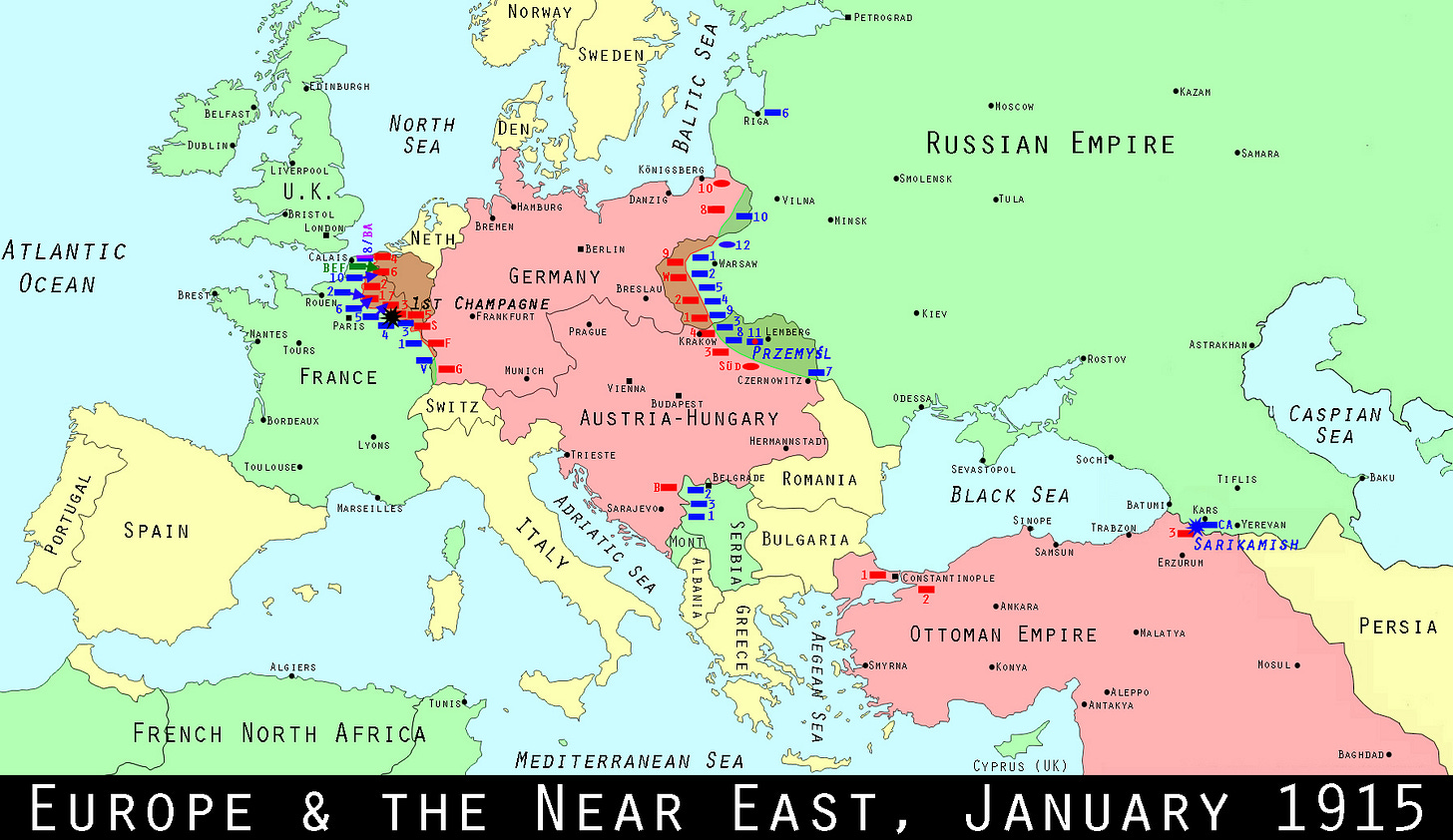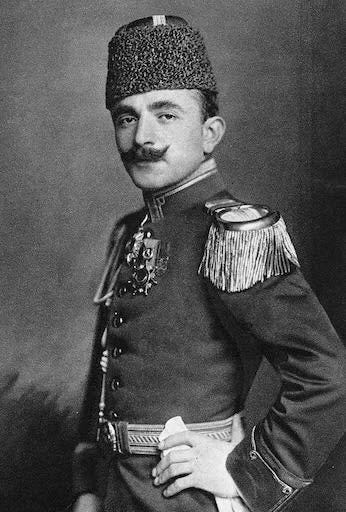Today in Caucasian history: the Battle of Sarikamish ends (1915)
The Ottomans suffer a massive setback along World War I's Caucasian Front.
If you’re interested in history and foreign affairs, Foreign Exchanges is the newsletter for you! Sign up for free today for regular updates on international news and US foreign policy, delivered straight to your email inbox, or subscribe and unlock the full FX experience:
The Battle of Sarikamish was one of the more overwhelming Russian victories of World War I. It was so overwhelming, in fact, that it put the Russians on the offensive in the Caucasus for good—or, well, until Russia quit the war following its 1917 revolution. Which is why its legacy is hard to judge. Whatever military gains the Russians made after Sarikamish were short-term, as the Ottomans were able to regain everything they’d lost after the Russian withdrawal. That said, the Russian victory here halted and turned back an early Ottoman offensive through the Caucasus that, had it been successful, might have turned the tide of war in a much different direction. Which isn’t nothing.
Outside of the military realm, the battle’s biggest impact was felt by the Armenian people. The Armenian Genocide was a long time coming and had multiple causes, but Sarikamish was one of its most immediate. And that has to do with one powerful man’s ego, and his desperate need to dodge the blame for his multiple, catastrophic failures on the battlefield.

The Caucasus Campaign began in November 1914, with Russian forces invading Ottoman territory. Even though the Russians fired the first shot, so to speak, the Caucasian front was far more an Ottoman priority than a Russian one. For the Russians, Europe was the main focus, and when things bogged down there they shifted tens of thousands of soldiers to that theater from the Caucasus. For the Ottomans, on the other hand, World War I was an opportunity to reverse the losses they’d suffered in the 1877-1878 Russo-Turkish War and, if they really hit the jackpot, to stir up revolutionary fervor among the Turkic peoples of the Russian Empire. From their standpoint the Caucasus was just as crucial, if not more so, than what was happening to the west.
You can see the degree to which the Ottomans prioritized the Caucasus in the fact that their operations there were directly overseen by Enver Pasha (d. 1922), the Ottoman Minister of War and probably the most powerful member of the triumvirate (which also included Grand Vizier Talaat Pasha and Minister of the Navy Djemal Pasha) that governed the empire in the period leading up to and during the war. As it turns out, though, Enver’s close oversight actually made things worse, and it’s his ego to which I was referring above. Which brings us to the Armenians.
What the Russians lost in military capability when they shifted resources to Europe they were able to restore, at least in part, thanks to a large outpouring of support from Armenians living in the Caucasus. Mostly this aid came from Armenians living in “Eastern Armenia,” which had become part of the Russian Empire in 1828 at the end of another Russo-Persian War. It was in eastern Armenia where a real sense of Armenian nationalism started to develop, and one of its core tenets became the “liberation” of western (Ottoman) Armenia. When the war started, and with Russian encouragement, tens of thousands of Russian Armenians formed volunteer militias that joined up with the invading Russian army, hoping to achieve that liberation.
The initial Russian invasion was halted by mid-November, and things stabilized with the Russians a few miles inside Ottoman territory. The Ottoman commander on the scene, Hasan İzzet, was content to leave things like this for the rest of the winter, but Enver Pasha had bigger plans. He devised a very dramatic, Napoleonic-style assault on the Russian lines, involving three corps attacking simultaneously along different parts of the line while a fourth unit conducted a diversion. This plan depended on all four units hitting their mark precisely on time and in force. To “ensure” that it succeeded, Enver dismissed the more cautious İzzet and assumed command himself. This, as you’ll see in a moment, ensured only that the whole effort would be a giant disaster.
Having given zero apparent thought to the logistics of implementing such an intricate plan in the dead of a Caucasian winter, Enver Pasha was presumably surprised when the whole thing collapsed due in part to inclement weather. When the battle first began on December 22, 1914, it looked like things would go the Ottomans’ way. Three Ottoman corps—the IX, X, and XI—moved into the positions they were to take prior to the final Ottoman strike. But the X Corps suffered something like 90% losses along the way, mostly to the folly of attempting a winter march through the imposing Allahüekber Mountains to get into position. The IX and XI corps also suffered heavy losses from hypothermia and illness. By the time they had made it to their staging positions, they were no longer in any condition to fight (having started out with around 120,000 soldiers, by this point the Ottomans had around 40,000 men still capable of combat). The Russians then began to withdraw from Sarikamish, and the whole Russian line started to maneuver in a way that Enver interpreted as a retreat. As it turns out, he was completely wrong.
When the IX and XI Corps launched their attack on the town of Sarikamish (which is in northeastern Turkey today) on December 29, their expected reinforcement from the X Corps never came because, well, there was no X Corps anymore. The weakened IX and XI corps were unable to break through the remaining Russian defenses into the town without taking heavy losses. And that Russian maneuver that Enver Pasha thought was a retreat? That was actually an encirclement, and it worked. The Russians began to surround the Turkish position, to disastrous effect if you happened to be an Ottoman soldier.
I could have written this post on January 7, because the battle really ended that day, when the defeated—annihilated, really—Ottomans began to fall back. But a few Ottoman units outside of Sarikamish held on until January 17, so here we are. Their losses were so severe that the entire Ottoman Third Army, its Caucasian force, was crippled. Enver’s failure was total: his grand plan looked great on paper but depended on the pieces coming together perfectly, which almost never happens and certainly wasn’t likely to happen in those conditions. He failed to account for the weather, failed to predict how the Russians would respond, failed to bring along enough of a reserve force to adjust if anything went wrong, and then, finally, failed to comprehend what the Russians were doing when they began shifting their forces around. Obviously, then, the Armenians were to blame. Wait, what?
When Enver returned to Constantinople he publicly claimed that he’d been defeated by Armenian betrayal, so as to cover up his many failures. There’s no question that the Armenians fighting alongside the Russians were invaluable to the Russian war effort. But those were Russian Armenians, not Ottoman Armenians. Needless to say, if you were an Armenian living in the Russian Empire you couldn’t possibly “betray” the Ottoman Empire. Treason doesn’t work like that. Unfortunately, such was Enver’s stature that his claims were not only believed but were then allowed to inform policy. As far as the empire was concerned, the Russian Armenian/Ottoman Armenian division ceased to matter. In February, all Armenians serving in the Ottoman military were demobilized due to fears that they were compromised by Russia. In April, the empire began deporting prominent Armenians, and by May it was undertaking mass deportations, which turned into death marches to concentration camps on the outskirts of Anatolia.
As for the Caucasus theater, things continued to mostly go in Russia’s direction, with some periodic setbacks, until mid-1916. That’s when the Ottomans put Mustafa Kemal in command of the Caucasian front (which by this time was really the Anatolian front because it had moved deep into Ottoman territory), and he was able to slow down the Russian advance. It was only after the Russian Revolution, however, that the Ottomans were able to push the front back to where it had been at the start of the war.



